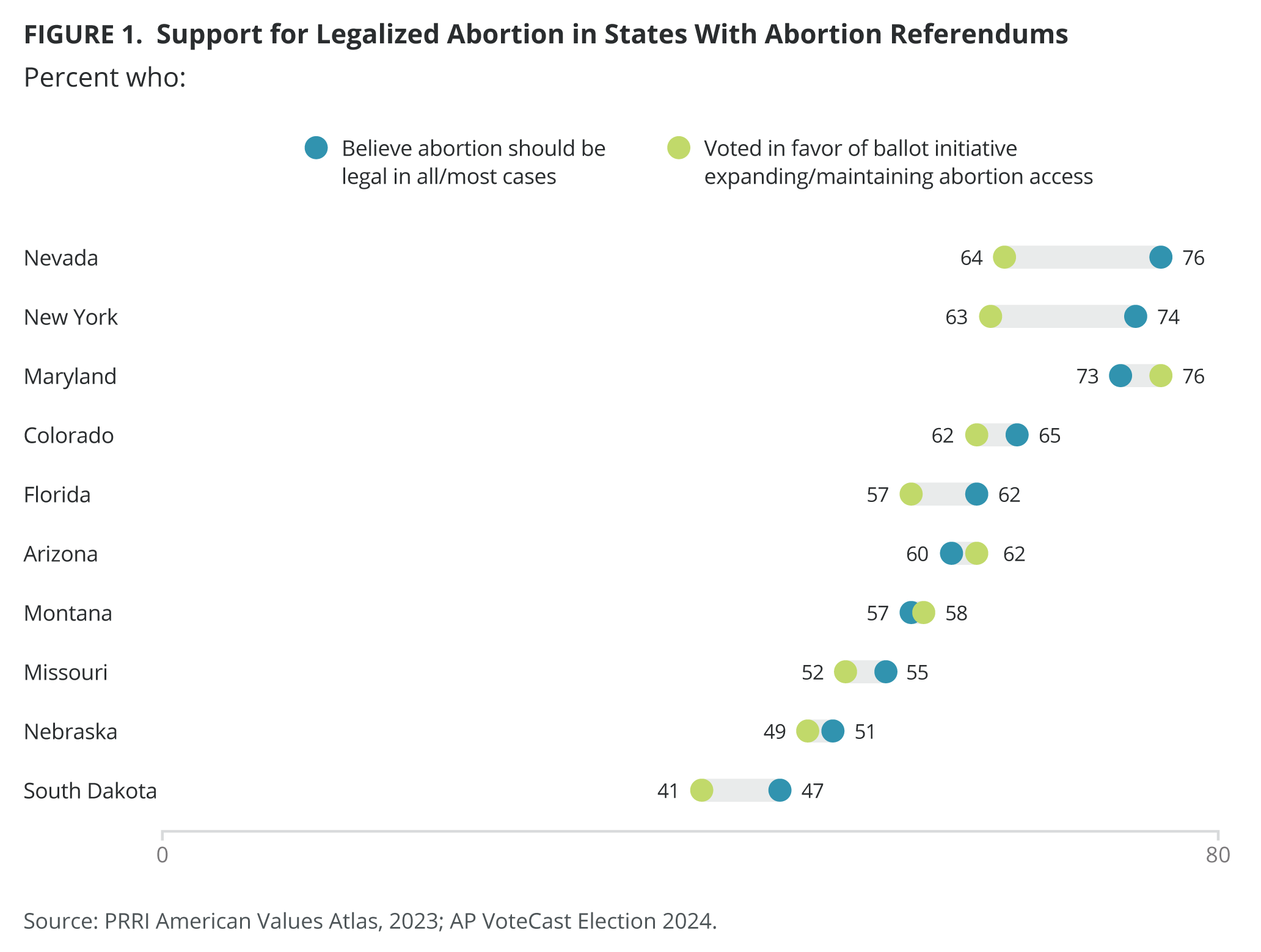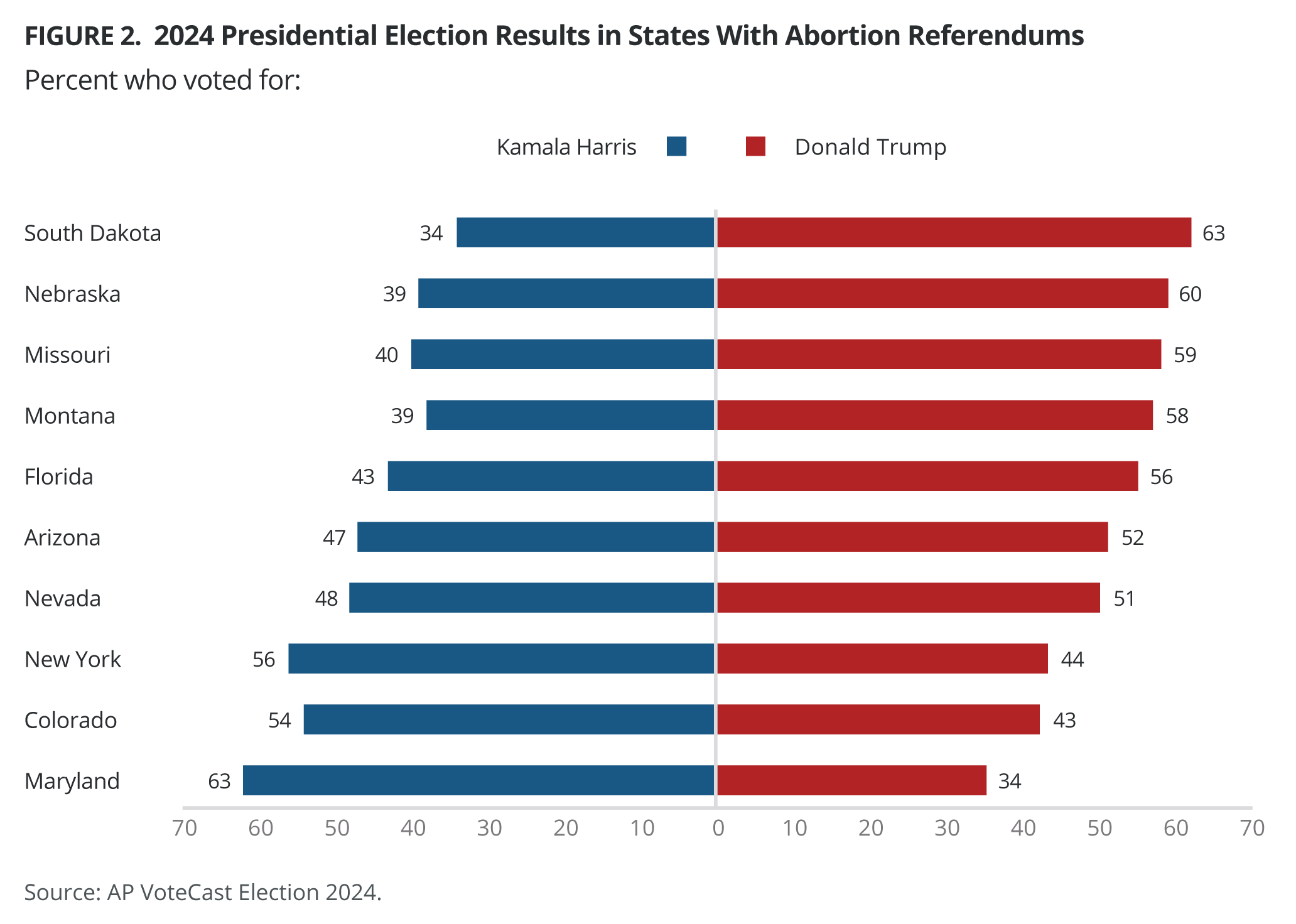Making Sense of 2024’s Abortion Ballot Initiatives

Dr. Anne Whitesell is a 2024-2025 PRRI Public Fellow focusing on reproductive health and rights. She is also an assistant professor of political science at Miami University in Oxford, Ohio.
A record 10 states voted on abortion during the November 2024 presidential election. Up until that point, every state where voters cast a ballot on reproductive rights had sided in favor of maintaining or expanding access to abortion since the U.S. Supreme Court’s 2022 Dobbs v. Jackson Women’s Health Organization decision. This Spotlight Analysis examines the results of the ballot initiatives in those 10 states in light of our knowledge concerning Americans’ views on abortion and how much they consider abortion in their decision about which candidates to support.
PRRI’s American Values Atlas shows that in 2023, majority of people in all 10 states that voted on reproductive rights in 2024 were against the Supreme Court overturning Roe v. Wade. Further, in 2023, a majority of people said abortion should be legal in all or most cases in 9 of the 10 states, including over 70% of Marylanders and New Yorkers, and 65% of Coloradans. It comes as no surprise, then, that measures introduced in Maryland and New York to protect abortion access passed in these heavily Democratic states, as well as in Colorado, which has become more Democratic in recent years. In all three states, the ballot measures outperformed Democratic presidential candidate Kamala Harris (62%, 56%, and 54%, respectively, voted for Harris).[1]
South Dakotans, by contrast, are more likely to identify as Republican than Democrat. And in 2023, only 47% of South Dakotans said abortion should be legal in all or most cases, the lowest percentage among all the states that held an abortion ballot initiative in 2024. South Dakota’s 2024 ballot initiative was more conservative than those of other states, allowing the state to regulate abortion in the second trimester “in ways that are reasonably related to the physical health of the pregnant woman. Still, the South Dakota ballot initiative did not pass when brought before voters, receiving support from only 41% of the electorate.

How do we make sense of the states where a majority of voters supported an abortion ballot initiative and voted for Republican candidate Donald Trump? Looking at the importance of abortion in Americans’ candidate choice in those states may provide some insight.
According to the 2023 American Values Atlas, over one-third of Americans (36%) say they would only vote for a candidate who shares their views on abortion, up from 21% in 2018. Nearly half of Americans (46%) say they consider a candidate’s position on abortion as just one of many important factors and 15% do not see abortion as a major issue.
In Florida, a majority of voters supported the proposed constitutional amendment to provide a right to abortion until fetal viability, but the state requires 60% support for constitutional amendments to pass; the abortion initiative fell short with 57% of the votes cast. Support for the ballot initiative, however, was 14 percentage points ahead of support for Kamala Harris, which amounted to 43%. This result may have been driven by the fact that 18% of Floridians do not see abortion as a major issue when choosing a candidate to support.
In two closely watched swing states — Arizona and Nevada — voters expanded access to abortion while voting for Donald Trump. In both states, more than 60% of voters supported ballot initiatives to amend the states’ constitutions to add a fundamental right to abortion. And, similar to Floridians, 17% of Arizonans and 19% of Nevadans do not see abortion as a major issue when choosing to support a candidate.
Voters in two predictably Republican states — Missouri and Montana — also amended their states’ constitutions to protect access to abortion. In Missouri, nearly 52% of voters supported adding a fundamental right to reproductive freedom to the state constitution. A majority of Missourians view a candidate’s stance on abortion as one of many factors when deciding who to vote for, and 10% do not see abortion as a major issue when choosing to support a candidate. This may explain why approximately 59% of Missouri voters supported Donald Trump.
Similarly, in Montana, 58% of voters supported amending the state’s constitution to provide a “right to make and carry out decisions about one’s own pregnancy, including the right to abortion” while allowing the state to regulate abortion after viability. At the same time, 58% of Montana voters supported Donald Trump.

The results in Montana are particularly striking given that approximately 30% of the state’s residents identify as white evangelical Protestant and, nationally, the vast majority of this group says that abortion should be illegal in all or most cases (70%).
There are still several states that allow for citizen-led initiatives that have yet to vote on reproductive rights. In the future, support for these initiatives may closely reflect public opinion data on views about the legality of abortion. Moreover, support for these initiatives may continue to cross party lines as significant percentages of voters detach their views on abortion from the candidates they support.
[1] For the most recent election data, see apnews.com/projects/election-results-2024/ballot-measures/; apnews.com/projects/election-results-2024/?office=P;

